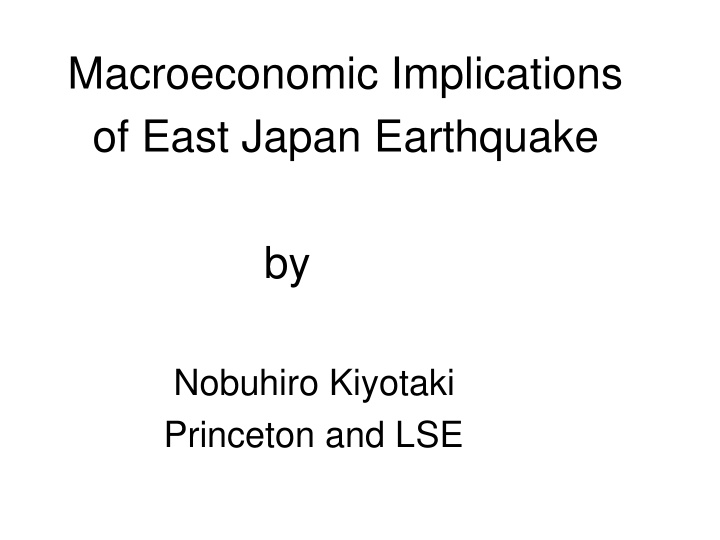



Macroeconomic Implications of East Japan Earthquake by Nobuhiro Kiyotaki Princeton and LSE
Impact on Factors of Production Aggregate output is produced from contribution share* labour 64% tangible capital 28% intangible capital 8% social capital (*McGrattan-Prescott) Tangible capital is relatively fast to recover Labour, intangible & social capital are slow to recover
Impact on the world economy Direct impact on downstream (supply) and upstream (demand) is large but limited Impact on energy is potentially large but substitutable Financial effect is small due to low leverage, (unless gov’t fails to regain long- run fiscal balance)
Value Loss Leverage Macro Impact 1998 Russian small Large Large crisis 2000 Tech Large small small bubble burst 2007-10 Large Large Huge Financial crisis 2011 Japan Large small small earthquake
A potential danger: Japanese public finance IMF Fiscal Monitor: April 2011 Fiscal balance 2008 2009 2010 2011 2012 %GDP Japan - 4.2 -10.3 - 9.5 - 10.0 - 8.4 US - 6.5 - 12.7 - 10.6 - 10.8 - 7.5 UK - 4.9 - 10.3 - 10.4 - 8.6 - 6.9 Euro - 2.1 - 6.4 - 6.0 - 4.4 - 3.6 Emerging - 0.6 - 4.9 - 3.8 - 2.6 - 2.2 market World - 2.0 - 6.7 - 5.7 - 4.7 - 3.5
0 1 @ Gov’t Debt A = ( interest rate - GDP growth ) � Gov’t Debt � GDP GDP + Primary De…cit � Seigniorage GDP GDP Gov’t Debt = (…nancial asset - liability) of (general govt +cen- tral bank - social security) = 160% of GDP at 2010 Primary balance = +1 : 7 1986 � 90 ; � 1 : 6 91 � 95 ; � 4 : 4 96 � 00 ; � 4 : 6 � 4 : 2 01 � 5 ; 06 � 10 FY % of GDP Interest rate - GDP growth = 1% ; average of advance economy Seigniorage is negligible ! Needs primary surplus of 1 : 6% for sustainability
Risk of delaying …scal reform: Interest rate risk Suppose nominal interest rate " by 1 : 5% , due to rise of spread and/or expected in‡ation Fiscal balance worsen by 2 : 4% of GDP (12 tril Yen) Bank of Japan cannot buy bonds if in‡ation is expected Price of long-term bond with coupon rate 1 : 5% Maturity 0 year 3 years 5 years 10 years 100 95.8 93.1 87.2
Direct impact of 1 : 5% interest rate hike B/S of Private Banks B/S of Private Banks ) Loan&Bond 920 C & Dep 1001 L&B 881 C & D 1001 Other 141 Net Worth 61 Other 141 Net Wor 21 B/S of Pensions and Insurance B/S of Pens and Insurance ) L&B 317 Ins & pen res 419 L&B 295 Ins & p res 419 Other 133 Net Worth 31 Other 133 Net Worth 9 Trilion Yen, Computed from Bank of Japan Flow-of-fund. As- sume average maturity of L&B = 3 years for banks, = 5 years for insurance ! Balance-sheet of …nancial intermediaries further worsen by fall in general asset prices
Balance-sheet contagion present future interest rate hike net worth of financial net worth of intermediaries falls intermediaries falls asset demand falls asset demand falls required return rises required return rises asset prices fall
Reaction to Loss of Capital Capital stock, output Without contagions With balance-sheet contagion Time
Future direction: Government must reform social insurance, raise retirement age and increase consumption tax gradually Bank of Japan needs to stop deflation while controlling inflation Firms should invest more on intangible capital, including on-the-job training of young workers We all have to contribute more to the society
Recommend
More recommend